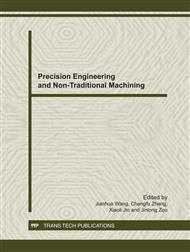[1]
J.C. Bezdek, Pattern Recognition with Fuzzy Objective Function Algorithms, Plenum, New York, 1981.
Google Scholar
[2]
G.C. Karmakar, L.S. Dooley, A generic fuzzy rule based image segmentation algorithm, Pattern Recognition Lett. 23 (10) (2002) 1215–1227.
DOI: 10.1016/s0167-8655(02)00069-7
Google Scholar
[3]
Y.A. Tolias, S.M. Panas, Image segmentation by a fuzzy clustering algorithm using adaptive spatially constrained membership functions, IEEE Trans. Systems Man Cybernet. A 28 (1998) 359–369.
DOI: 10.1109/3468.668967
Google Scholar
[4]
D.L. Pham, Fuzzy clustering with spatial constraints, in: IEEE Proceedings of the International Conference Image Processing, New York, 2002, pp. II-65–II-68.
Google Scholar
[5]
M.N. Ahmed, S.M. Yamany, N. Mohamed, A.A. Farag, T. Moriarty, A modified fuzzy c-means algorithm for bias field estimation and segmentation of MRI data, IEEE Trans. Med. Imaging 21 (2002) 193–199.
DOI: 10.1109/42.996338
Google Scholar
[6]
A.W.C. Liew, H. Yan, An adaptive spatial fuzzy clustering algorithm for 3-D MR image segmentation, IEEE Trans Med Imag, 2003,22:1063–1075.
DOI: 10.1109/tmi.2003.816956
Google Scholar
[7]
K.S. Chuang, H.L. Tzeng, S, Chen, J. Wu, T.J Chen, Fuzzy c-means clustering with spatial information for image segmentation, Computerized Medical Imaging and Graphics, 2006, 30: 9–15.
DOI: 10.1016/j.compmedimag.2005.10.001
Google Scholar
[8]
Jajuga K. L norm based fuzzy clustering, Fuzzy Sets Syst., 1991, 39(1): 43–50.
DOI: 10.1016/0165-0114(91)90064-w
Google Scholar
[9]
R.J. Hathaway, J.C. Bezdek, Generalized fuzzy c-means clustering strategies using L norm distance, IEEE Trans Fuzzy Syst, 2000, 8: 576–572.
DOI: 10.1109/91.873580
Google Scholar
[10]
J. Leski, An insensitive approach to fuzzy clustering [J]. International Journal of Applicat Math Comp Sci, 2001,11(4):993–1007.
Google Scholar
[11]
D.L. Pham, J.L. Prince, Adaptive fuzzy segmentation of magnetic resonance images, IEEE Trans Med Imag, 1999, 18:737-752.
DOI: 10.1109/42.802752
Google Scholar
[12]
H. Renjie, S. Datta, B.R. Sajja, et al, Adaptive FCM with contextual constrains for segmentation of multi-spectral MRI, in: Proceedings of the 26th Annual International Conference of the IEEE EMBS. 2004:1660-1663.
DOI: 10.1109/iembs.2004.1403501
Google Scholar
[13]
S.C. Chen, D.Q. Zhang, Robust image segmentation using FCM with spatial constraints based on new kernel-induced distance measure, IEEE Trans. Systems Man Cybernet. B 34 (4) (2004) 1907–1916.
DOI: 10.1109/tsmcb.2004.831165
Google Scholar
[14]
W.L. Cai, S.C. Chen, D.Q. Zhang, Fast and robust fuzzy c-means clustering algorithms incorporating local information for image segmentation, Pattern Recognition 40 (2007) 825 – 838
DOI: 10.1016/j.patcog.2006.07.011
Google Scholar


